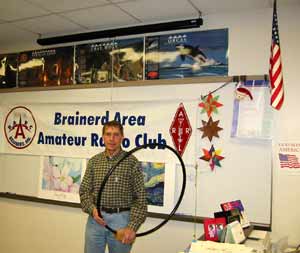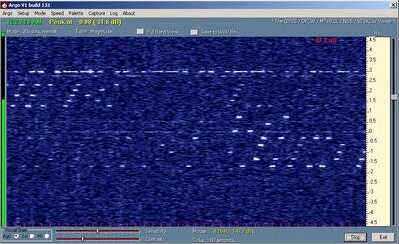Above is a compressed
screenshot from a listener in Arizona, showing LowFERs "IP"
(Mississippi), LEK (KØLR) and "DEX" (North Carolina) as
received using a spectrogram program called "Argo". IP is
sending very slow Morse, with dot lengths of 30 seconds, while LEK and DEX
are using a "broadband" multi-tone Hellschreiber mode. There are
a couple of other slow CW signals in the picture, a little too weak to
identify. The center frequency of the display is at 185.300 kHz, and the
total bandwidth occupied by all of the signals is less than 5 Hz.
|

Lyle KØLR holding a loop receiving
antenna
photo by Mark WØMH
|
LOW FREQUENCY EXPERIMENTAL RADIO
(LowFER)
Presented by Lyle Koehler, KØLR
on February 27, 2003 |
Although the early developments in low frequency (LF) radio took place about a century ago, this unique part of the radio spectrum continues to fascinate a small group of amateur radio operators and other experimenters in the US and elsewhere. Practical radio communication got its start on LF. The sinking of the Titanic in 1912 precipitated the enactment of new radio laws, and hams were banished to the "useless" wavelengths below 200 meters. For most of the ham radio community and the general public in the US today, the frequency range below the AM broadcast band is unfamiliar territory. But within the next few months, the US is likely to join other countries in the world with a ham band at 137 kHz.
LF offers true surface-wave coverage for several hundred miles, whereas on 160 meters, the lowest frequency ham band in the US, the true ground wave is usable only to 100 miles or less. Sky-wave propagation can extend LF coverage to a thousand miles or more, although ionospheric absorption takes a severe toll on LF multi-hop propagation. The propagation path is typically very stable, with fade cycles of many minutes or even hours, and it is easy at these low frequencies to build equipment with extremely good frequency stability and accuracy. Compared to the HF or VHF range, LF is practically DC, so construction techniques and components are not at all critical. Unfortunately, with a wavelength on the order of a mile, any reasonable sized antenna will be terribly inefficient, and the more efficient it is, the narrower the bandwidth. Atmospheric and man-made noise increases as you go lower in frequency, with the noise amplitude following almost a 1/f law.
Two-way radio communication below 500 kHz has been virtually extinct for decades. Are the frequencies below 500 kHz still used at all? The answer is a definite yes, starting with the US Navy's ELF transmissions at about 76 Hz (yes, Hz, not kHz or MHz). From 15 to 50 kHz there are a number of minimum-shift-keyed (MSK) signals used for worldwide message transmission by navies of various countries. Anyone in the US with an "atomic clock" is receiving the 60 kHz time signals from WWVB. Loran-C
radio navigation, centered at 100 kHz, may not be phased out until the year 2015 (and unfortunately will be a major source of QRM at 137 kHz). In Europe, Asia and Africa there are longwave broadcast transmissions between about 150 and 300 kHz, where extended surface wave propagation and megawatt power levels allow coverage of an entire country, or all of Europe. In the US, Canada and some other regions of the world, thousands of aeronautical non-directional beacons operate between 190 and 530 kHz. Examples of local beacons are BR (Brainerd, 251 kHz), SAZ (Staples, 257 kHz), DL (Duluth, 379 kHz), AIT (Aitkin, 397 kHz) and XCR (Fort Ripley, 404 kHz). Power-line carrier signals (supposedly non-radiating) also populate the LF spectrum.
Despite the lack of a US ham band on LF, for many years it has been possible to operate legally down there, although with severe restrictions. Part 15 of the FCC rules permits unlicensed operation in the 160-190 kHz range with a DC power input of 1 watt to the transmitter final amplifier, and an antenna length no greater than 15 meters (including the transmission line and ground wire, if used). To put things in perspective, that is the equivalent of an 8-inch whip on 14 MHz. The best LowFER installations have achieved effective radiated power levels of about 5 milliwatts. Transmitting loops are becoming popular, but most LowFERs use a simple vertical with a top hat, and a very good ground radial system. For example, my LEK beacon employs a "flat top" suspended above a metal garage roof, while BRO
(KIØLE) in Duluth has a 42-foot mast with a top hat radius of 8 feet. The loading coil required for a LowFER antenna typically is the size of a 5-gallon bucket. Part 15 devices require certification, which is a prohibitively expensive process in view of the limited market for LowFER equipment. However, this requirement is waived for home-built devices as long as "good engineering practice" is used to ensure compliance with the rules. This means that "home brewing" a LowFER transmitter is not only a fun way to go, it's the only way to go! LowFER transmitter circuits can be as simple as a crystal oscillator and CMOS divider with a complementary pair of plastic switching transistors in the final. The receivers in many ham transceivers cover the LF range, but reception of weak LowFER signals usually requires some sort of active antenna, either a whip or a loop, with a simple preamplifier circuit.
Single sideband (SSB) and frequency modulation (FM) voice are the most popular modes of operation on the amateur bands. However, with the power and antenna restrictions of Part 15, the effective range of LowFER voice transmissions is only a few miles. Most LowFER operation used Morse code ("CW") until the widespread availability of high-speed computers with sound cards brought digital signal processing (DSP) techniques within the reach of the average experimenter. Audible copy of CW has been replaced by spectrogram software such as "Argo" and "Spectran" that let you see the dots and dashes of very slow CW (QRSS) on the screen, with signals separated by less than 1 Hz. The theoretical 6 dB advantage of binary phase-shift keying (BPSK) over on-off keying has been exploited in modes such as "Coherent BPSK" and "WOLF", and a recent variation of multiple-tone frequency shift keying (MFSK) called "Jason" has proven very effective for LowFER use. With a few notable exceptions such as the amazing reception of California LowFER "Z2" in Hawaii about 20 years ago, distances for one-way CW beacon reception have rarely exceeded 1000 miles, and only a few two-way contacts have been made at 700 miles or more. But with the new DSP modes, one-way distances of 1000 miles are common (even though it might take all night to copy a 3-letter identifier).
Recently, ham operation has been authorized in many European countries at 135.7 to 137.8 kHz, and in New Zealand at 160-190 kHz. Last year the FCC, responding to an ARRL petition, issued a Notice of Proposed Rule Making that would create a ham band in the 136 kHz range, with a power output of 100 watts or an effective radiated power of 1 watt, and a maximum bandwidth of 100 Hz. A US ham allocation on LF would bring about new innovations in communication techniques, and probably more use of commercial equipment. However, I expect that LF will always remain an experimenter's haven. You can find a wealth of information on low-frequency operation on the Internet. The Longwave Club of America's web page at http://www.lwca.org and my own web site at
http://www.computerpro.com/~lyle are good places to start.
Lyle KØLR
|
Minnesota
non-directional beacons, from a list that is several years old. |
Call KHz City
ACQ 371 WASECA
AIT 397 AITKIN
AJW 281 ALEXANDRIA
AP 338 MINNEAPOLIS
AQP 356 APPLETON
BA 385 ST PAUL
BBB 239 BENSON
BFW 350 SILVER BAY
BR 251 BRAINERD
CBG 350 CAMBRIDGE
CHU 209 CALEDONIA
CKC 358 GRAND MARAIS
CKN 400 CROOKSTON
COQ 335 CLOQUET
CQM 233 COOK
DL 379 DULUTH
DXX 227 MADISON
ETH 326 WHEATON |
Call KHz City
FF 337 FERGUS FALLS
FQ 364 FAIRMONT
FSE 224 FOSSTON
GB 253 MARSHALL
GHW 346 GLENWOOD
GP 272 GRAND RAPIDS
HCD 209 HUTCHINSON
HY 260 THIEF RIVER FALLS
IL 389 WILLMAR
IN 353 INTERNATIONAL FALLS
JMR 327 MORA
JYG 260 ST JAMES
LXL 359 LITTLE FALLS
MD 371 BEMIDJI
MJQ 353 JACKSON
MS 266 MINNEAPOLIS
MWM 203 WINDOM
MZH 362 MOOSE LAKE |
Call KHz City
ORB 341 ORR
OT 277 WORTHINGTON
PFT 342 PINECREEK
PK 269 PARK RAPIDS
PNM 368 PRINCETON
PPI 400 ST PAUL
PQN 284 PIPESTONE
RGK 394 RED WING
RS 329 ROCHESTER
SAZ 257 STAPLES
SBU 332 BLUE EARTH
SCG 385 CRANE LAKE
ST 342 ST CLOUD
SW 360 WARROAD
TWM 243 TWO HARBORS
ULM 272 NEW ULM
VVV 332 ORTONVILLE
XCR 404 LITTLE FALLS |
|


 Jim Shubert KCØANQ, BAARC V.P. and
Program Chairman.
Jim Shubert KCØANQ, BAARC V.P. and
Program Chairman.![]() Back to the BAARC History Page
Back to the BAARC History Page
![]() Back to 2003
Back to 2003